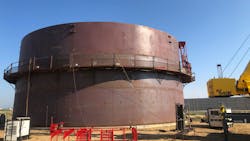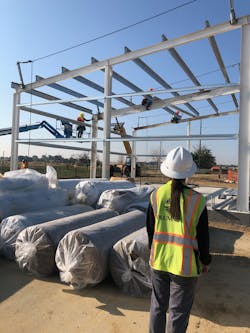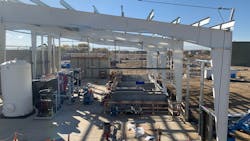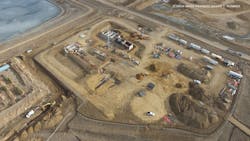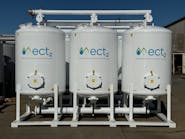In the 1930s, farmers in northeastern Colorado suffered through the Great Depression, droughts, and dust storms that crippled their ability to raise crops. The tipping point rested on insufficient water supplies to survive the agricultural season. A creative solution was proposed to collect Western Slope Mountain water from the headwater of the Colorado River and divert it to Colorado’s Front Range and plains to provide water, primarily for agricultural purposes.
What is now known as the Colorado-Big Thompson Project (C-BT) was signed by President Franklin Delano Roosevelt in 1937. It was hailed as an innovative idea that served many Front Range communities well. However, 85 years later, the Town of Firestone is recognizing C-BT’s limitations and taking alternative water delivery into their own hands.
The C-BT is Firestone’s sole source of water and has been the primary provider of water rights for most cities, towns, and municipal water districts in Northern Colorado. Its high-quality, reliable water supplies have been essential for new development projects and expansion efforts. Yet, after decades of dominance, C-BT’s water shares are running out.
Shifting Priorities
When the C-BT project started delivering water in the early 1950s, municipal users held about 10 percent of the 310,000 C-BT units. In 2020, over 70 percent of the same 310,000 units are held by municipal and industrial users. During that time, the Northern Colorado water market has become one of the most active water markets in the western United States — with annual water sales over $60 million, which includes increasing prices to purchase limited C-BT water shares.
While Firestone’s water supply includes 22.3 million gallons per day (MGD) from C-BT and Windy Gap Reservoir, the town made a historic decision to divert some of its water supplies away from C-BT to create new and more affordable water delivery alternatives. Firestone plans to do this by converting irrigation water into residential tap water by building a flexible water treatment plant that could adapt to current and future water sources.
To embrace a new level of water independence and control, Firestone’s plan began more than 20 years ago when its population was approximately 2,269 residents. In the last 10 years, the town’s population has grown by 60 percent. In order to accommodate this growth, Firestone’s 2020-2050 Water Action Plan includes an investment of $50 million to diversify and treat its raw water portfolio.
The first step in the plan includes the purchase of land, the construction of a new water treatment plant and a deep injection well site in order to produce 1.5 MGD. Step two involves expanding the treatment plant’s capacity to 2.25 MGD between the years 2025-2030. The final step aims to maximize treatment capacity to 5 MGD by the year 2050 to serve an additional 10,000 households.
Declaration of Water Independence
Expected to finish construction in April 2022, Firestone’s St. Vrain Water Treatment Plant (SVWTP) will capture and treat local alluvial water from the St. Vrain Creek — a tributary that runs through the town and has historically served as a source for irrigation water for local farmland.
Firestone engaged experts from the Colorado Civil Group, LRE Water, and Plummer to include reverse osmosis (RO) in the plant’s design. RO will reduce the source water’s high bromide concentrations and help the town to adapt to the composition and treatment requirements of future water sources.
If true surface water sources are brought to the plant, the pretreatment system can handle higher suspended solids and turbidity. If additional sources have lower bromide concentrations and no individual constituent requiring removal through RO, there are pipes and valves to allow for partial bypass of the RO trains. Bypass provisions are also included for the calcite contractors, to allow for flexibility in stabilization treatment.
Overall, the plant is designed to be robust, flexible, and resilient — with the goal of serving the highest quality water to Firestone’s customers today and into the future.
“We are actively implementing innovative strategies to develop and expand our raw water reservoir storage,” said A.J. Krieger, Firestone’s town manager. “Our plan includes a requirement for our development partners to contribute to Firestone’s water infrastructure costs, which means we can make smart growth decisions that pay for themselves.”
Design Triumphs
The new water treatment plant will allow Firestone to do something it’s never done before: capture reusable water.
The C-BT requires water to be returned to its previous supply level to fulfill its obligation to provide water to downstream users. The water collected from the St. Vrain Creek is categorized as reusable water that can be recaptured, treated, and returned for use in Firestone.
This creates new opportunities for Town leaders to develop long-term sustainable water alternatives with a facility that is designed to incorporate the newest water treatment protocols. This includes the use of chlorine dioxide, coagulation, 3-stage flocculation, sedimentation using plate settlers, pressurized ultrafiltration membranes (UF), RO, corrosion control using calcite contractors and orthophosphate, and/or disinfection using gas chlorination.
The project also includes a 0.5 MG welded steel raw water storage tank, a below-grade chlorine contact clearwell, a backwash recovery system with geotubes, a lined pond and recycle pumps, an approximately 20,000-square-foot metal building, and a 1.0 MG welded steel finished water storage tank. LRE Water and Plummer collaborated to evaluate RO brine disposal options; and the facility has plans to use deep well injection disposal. Construction is expected to be completed in April 2022.
As additional raw water sources are developed and as demand increases, the plant’s capacity will also increase. By adding additional pumps, UF trains, and building out the RO skids now, the plant can be expanded to 2.25 MGD within it’s the building’s existing 20,000 square-foot footprint.
Then, by constructing a parallel flocculation and sedimentation train, further expanding the UF and RO units, and adding 10,000 square-feet in additional building space, the SVWTP can achieve the up to 5 MGD treatment capacity by its goal year of 2050.
Financial Security
Under Firestone’s Water Action Plan, the Town will sell residential water taps from its new water treatment plant to developers, using the money to reinvest in the Town’s water infrastructure.
“This historic decision affords the Town greater water independence and control while also creating new revenue streams to pay for responsible growth and development,” said Firestone Mayor Bobbi Sindelar. “Our plan has already provided millions of dollars in new revenue through two new water agreements that were recently signed. We are also negotiating additional agreements that will produce the same outcomes of financial security and smart planning.”
The decision to create redundant water supplies and to embrace a new level of water independence sets Firestone apart from other towns whose fates are still tied to C-BT’s dwindling water shares and soaring prices. Firestone’s Water Action Plan can serve as a blueprint for other communities carving out their own water independence. WW
Published in WaterWorld magazine, March 2022.
